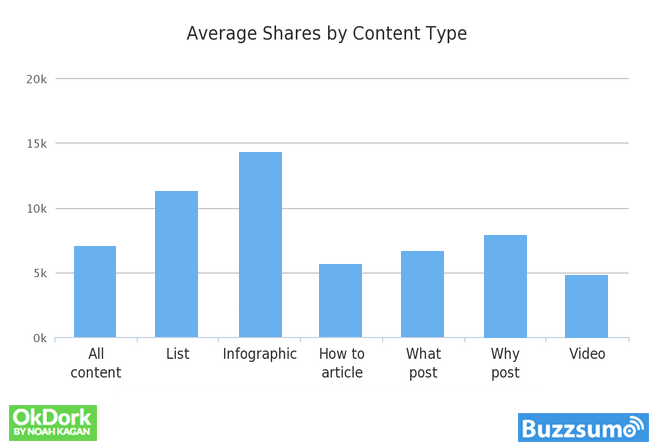
Are you getting the biggest bang for your buck with list posts? List posts have become more popular in recent years and are still the rage. Thinking about social media marketing, and social shares, list posts are second to infographics in shares.
Here’s the results of 1 million posts analyzed by BuzzSumo for content shares based on content type.

Given that some marketers write list posts because they seem “easy” content to create, list posts cannot be haphazardly thrown together and succeed. There’s no excuse for crappy content, even with a format such as a list.
What should you pay attention to with list posts? Well, here’s a list of common reasons why a list post can miss the mark.
#1: Poor scannability
Lists posts are made for easy-on-the-eyes and easily scanned to get the gist of the points. Readers want to quickly understand the information being conveyed. So poorly scannable posts obviously frustrate and annoy the reader; and it’s a failed post.
For the hurried reader, just scanning the numbered sub-headings in this post is all that’s needed. If something really piques their interest, then they can read the content for a given point.
#2: Failing to use images
The importance of using relevant images holds for list posts just like it does for regular blog posts and social media posts. Readers gravitate to images faster than they do to text.
And images make the text easier to understand. It’s a natural process that should be capitalized on.
Here’s the results of 1 million posts analyzed by BuzzSumo for content shares with and without images. It’s compelling.

The subject of images and what works best and when is a whole other field of study. You can use images that represent data, for instance; or psychology-driven images work very well when based on what’s known to work.
#3: Using the wrong number of list items
Old copywriting research holds that using an odd number of items works better than an even number. But that’s for bullet points and not list items that comprise the actual content.
Research shows that list posts with 10 items garners the most shares. We’ve all seen “Top 10 … “ headlines all over the net.
If you want to give your list post the best chance, then use 10 items. And yes, maybe you’ve noticed that this list post violates that rule. It’s OK. I’m more concerned about giving you the correct data, and rest assured 10 items is the sweet spot.
#4: Writing for the wrong audience
Or, not knowing how to write to your audience. A list post written for consumers will not be the same in style or content as it would be for business owners.

Businesses want actionable information, or information that helps them in some way, immediately and it should be substantiated. Consumers tend to be lacking in focus, and while they also want good information, instantly, many are not as concerned with lengthy explanations and data.
#5: Skipping the introduction for your post
Introductions exist for a reason. Remember people are in a hurry and tend to scan.
If they get past the headline, they’re looking to find out what the post is about from the introductory paragraph. If it’s not there, or the intro is vague – they’re gone.
Introductions are (seriously) not hard to write; so be sure you have a proper intro in all your posts including list posts.
#6: Not writing a conclusion
The conclusion is necessary for all posts just as the introduction is necessary. There’s no need to make it long, either. A succinct summary of the post’s main points is the bare-bones conclusion.
Remember that people scan the post and jump around to the parts that interest them the most. And some will read the conclusion, with its summary, and then decide where to go from there.
For some readers, the conclusion has the same effect as the PS in a sales letter.
#7: There’s no meat to your list items
Creating a list post should not be thrown together willy-nilly, without thought, etc. You know your readers will pick-up on it.
While yes, content still reigns supreme – it has to be good if not great which means all the things you know. It must be something people can sink their teeth into; it has to have some kind of wow factor. You must know what your audience wants and needs; there’s no way around it.
If you’re vying for search engine traffic, then you’ll need to do more than the standard 500 word, general content posts. It’s common to see posts from 1000 upwards to 2000 words or more.
Here’s the results of 1 million posts analyzed by BuzzSumo for content length and amount of social shares.

#8: There’s no reader engagement
You can and should strive to engage your audience with every form of content, including the list post. How do you do that?
Easy, you talk to them (using “you” and “your”) and reference your self using “I.”
Talk to your readers just like you would in a real conversation.
You can also ask questions throughout the post; stimulate their minds and make them think about what’s important. That’s not hard to do, don’t you agree?
Conclusion
Writing list posts is fun, and readers can learn very quickly and appreciate the information you’ve given. If you avoid the mistakes I talked about and use the tips I gave you, your social shares (and traffic) should increase.
List posts are used in all markets and niches, so avoid thinking they won’t work for your niche. Just be sure you follow the guidelines given here.
I can help you avoid many more types of marketing mistakes while showing you how to create a product and get into profits very quickly.
Tags: how to get more social shares, how to write list posts, list posts, write good posts
Leave A Reply (No comments So Far)
No comments yet